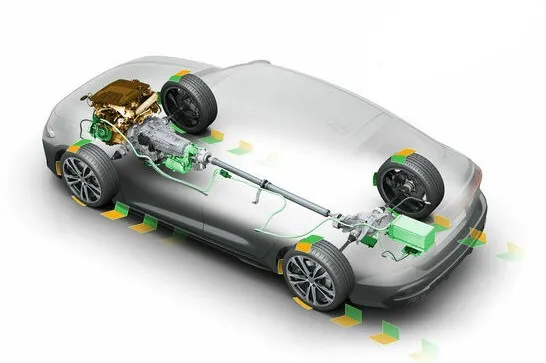Audi ‘MHEV plus’: The next-gen, 48-volt mild-hybrid technology
The ‘MHEV plus’ technology of Audi combines the strengths of the powertrain generator (PTG), belt alternator starter (BAS), and a lithium iron phosphate (LFP) battery to support the IC engine for higher efficiency and performance.
German automaker Audi’s new A5 and Q5 series will debut the next-generation ‘MHEV plus‘ mild-hybrid technology. The company claims that the system will aid the IC engine, boost its performance and agility, and reduce carbon emissions. Both front-wheel and all-wheel drive ‘quattro’ models can make use of this modular system.
The 48-volt mild-hybrid systems consists of three important components. First, the powertrain generator (PTG), with integrated power electronics and a permanently excited synchronous motor (PSM). The compact unit is directly integrated onto the output shaft of the transmission, a stark departure from the previous system.

As a result, the module contributes up to 18 kW of electrical power to the drive. It also enables a 230 Nm of max torque at the transmission output, acting as a boost to the engine performance. The drivetrain utilizes the PTG in speeds up to 140 kmph. At even higher speeds, the system disengages itself.
Second important component of the hybrid system is the belt alternator starter (BAS). It starts the engine and delivers energy to the battery. Audi says that the belt drive has acoustic advantages over a pinion starter, while also achieving higher starting speed for the engine.
Also Read: Volkswagen puts its acclaimed ‘VR6’ engines to rest after 36 years
Moving on, the third component of the ‘MHEV plus’ is its 1.7 kWh LFP battery pack. It can deliver a max power of 24 kW. Interestingly, Audi is using LFP battery for its mild-hybrid system for the first time. The integrated brake control system (iBRS) recovers energy through regenerative braking.
The ingenuity of the mild-hybrid system is its ability to deliver high currents to the electric motor and store excess energy during recovery. The battery SoC usually hovers around 50 to 60 percent at its peak efficiency. The system’s objective is to recover as much energy as possible and quickly reuse them for the drive.
Therefore, pure-electric driving range is not the actually utility of this hybrid system. The system can still run the car with its engine off at certain nominal speeds. During sudden acceleration or when the the Adaptive Cruise Control (ACC) exceed a speed threshold, the system brings alive the engine for instant power.
Also Read: Audi Q8 Concept: This Is How Future SUVs Are Going To Be!
Audi says that its new mild-hybrid system can significant improve the car’s fuel efficiency. The system even makes the drive smooth and comfortable, especially for longer travels.










